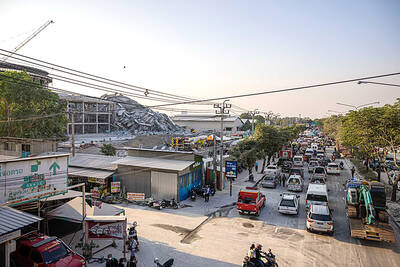Without reforms, the world will be plunged into a water crisis that could be crippling for hot, dry countries, the UN warned yesterday.
In an annual report, the UN said abuse of water was now so great that on current trends, the world will face a 40 percent “global water deficit” by 2030 — the gap between demand for water and replenishment of it.
“The fact is there is enough water to meet the world’s needs, but not without dramatically changing the way water is used, managed and shared,” it said in its annual World Water Development Report.
“Measurability, monitoring and implementation” are urgently needed to make water use sustainable, said Michel Jarraud, head of agency UN-Water and the World Meteorological Organization.
Surging population growth is one of the biggest drivers behind the coming crisis, the report said.
The Earth’s current tally of approximately 7.3 billion humans is growing by about 80 million per year, reaching a likely 9.1 billion by 2050.
To feed these extra mouths, agriculture, which already accounts for about 70 percent of all water withdrawals, will have to increase output by approximately 60 percent.
The report pointed to a long list of present abuses, from contamination of water by pesticides, industrial pollution and runoff from untreated sewage, to over-exploitation, especially for irrigation.
More than half of the world’s population takes its drinking supplies from groundwater, which also provides 43 percent of all water used for irrigation.
About 20 percent of these aquifers are suffering from perilous over-extraction, the report said.
By 2050, global demand for water is likely to rise by 55 percent, mainly in response to urban growth.
“Cities will have to go further or dig deeper to access water, or will have to depend on innovative solutions or advanced technologies to meet their water demands,” the report said.
The overview, scheduled for release in New Delhi, draws together data from 31 agencies in the UN system and 37 partners in UN-Water.
It placed the spotlight on hot, dry and thirsty regions which are already struggling with relentless demand.
In the North China Plain, intensive irrigation has caused the water table to drop by more than 40m in some places, it said.
In India, the number of so-called tube wells, pulling out groundwater, rose from less than a million in 1960 to nearly 19 million 40 years later.
“This technological revolution has played an important role in the country’s efforts to combat poverty, but the ensuing development of irrigation has, in turn, resulted in significant water stress in some regions of the country, such as Maharashtra and Rajasthan,” the report said.
Water expert Richard Connor, the report’s lead author, said the outlook was bleak for some areas.
“Parts of China, India and the United States, as well as in the Middle East, have been relying on the unsustainable extraction of groundwater to meet existing water demands,” he said.
“In my personal opinion this is, at best, a short-sighted plan B. As these groundwater resources become depleted, there will no plan C, and some of these areas may indeed become uninhabitable,” he said.

US President Donald Trump yesterday announced sweeping "reciprocal tariffs" on US trading partners, including a 32 percent tax on goods from Taiwan that is set to take effect on Wednesday. At a Rose Garden event, Trump declared a 10 percent baseline tax on imports from all countries, with the White House saying it would take effect on Saturday. Countries with larger trade surpluses with the US would face higher duties beginning on Wednesday, including Taiwan (32 percent), China (34 percent), Japan (24 percent), South Korea (25 percent), Vietnam (46 percent) and Thailand (36 percent). Canada and Mexico, the two largest US trading

AIR SUPPORT: The Ministry of National Defense thanked the US for the delivery, adding that it was an indicator of the White House’s commitment to the Taiwan Relations Act Deputy Minister of National Defense Po Horng-huei (柏鴻輝) and Representative to the US Alexander Yui on Friday attended a delivery ceremony for the first of Taiwan’s long-awaited 66 F-16C/D Block 70 jets at a Lockheed Martin Corp factory in Greenville, South Carolina. “We are so proud to be the global home of the F-16 and to support Taiwan’s air defense capabilities,” US Representative William Timmons wrote on X, alongside a photograph of Taiwanese and US officials at the event. The F-16C/D Block 70 jets Taiwan ordered have the same capabilities as aircraft that had been upgraded to F-16Vs. The batch of Lockheed Martin

GRIDLOCK: The National Fire Agency’s Special Search and Rescue team is on standby to travel to the countries to help out with the rescue effort A powerful earthquake rocked Myanmar and neighboring Thailand yesterday, killing at least three people in Bangkok and burying dozens when a high-rise building under construction collapsed. Footage shared on social media from Myanmar’s second-largest city showed widespread destruction, raising fears that many were trapped under the rubble or killed. The magnitude 7.7 earthquake, with an epicenter near Mandalay in Myanmar, struck at midday and was followed by a strong magnitude 6.4 aftershock. The extent of death, injury and destruction — especially in Myanmar, which is embroiled in a civil war and where information is tightly controlled at the best of times —

China's military today said it began joint army, navy and rocket force exercises around Taiwan to "serve as a stern warning and powerful deterrent against Taiwanese independence," calling President William Lai (賴清德) a "parasite." The exercises come after Lai called Beijing a "foreign hostile force" last month. More than 10 Chinese military ships approached close to Taiwan's 24 nautical mile (44.4km) contiguous zone this morning and Taiwan sent its own warships to respond, two senior Taiwanese officials said. Taiwan has not yet detected any live fire by the Chinese military so far, one of the officials said. The drills took place after US Secretary